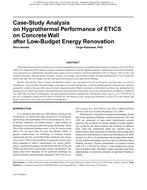Description
Hygrothermal performance of mineral wool and expanded polystyrene external thermal insulation composite system (ETICS/EIFS) was studied in field conditions and by computer simulations with the Delphin program. Temperature and relative humiditywere measured in a additionally insulated large panel concrete element wall from September 2011 to January 2013 in the coldclimate of Estonia. Measurements of indoor climate, air leakage, and thermal bridges through building fabric were conductedbefore and after the low-budget energy renovation pilot project of an apartment building.
Results showed that indoor climate and thermal comfort were not improved a lot in all aspects and the same was true forairtightness. Unacceptable thermal bridges remained at external wall/balcony, external wall/foundation wall junction, and alsoaround the windows because they stayed in their original position. Built-in moisture of the whole wall dried out during the firstheating season. Better agreement was found between measured and results if the convective moisture flow in addition to diffusionwas taken into account in simulations. Average measured thermal transmittance during the winter was Uwall 0.17 W/(m² x K) inthe case of graphite enhanced EPS and 0.19 W/(m² x K) with mineral wool. Long-term durability of ETICS in cold climate andunder wind driven rain loads need further investigation.
Presented at Thermal Performance of Exterior Envelopes of Whole Buildings XII, December 2013
Citation: Thermal Performance of Exterior Envelopes of Whole Buildings XII
Product Details
- Published:
- 2013
- Number of Pages:
- 14
- File Size:
- 1 file , 7.4 MB
- Product Code(s):
- D-BldConf13-43




